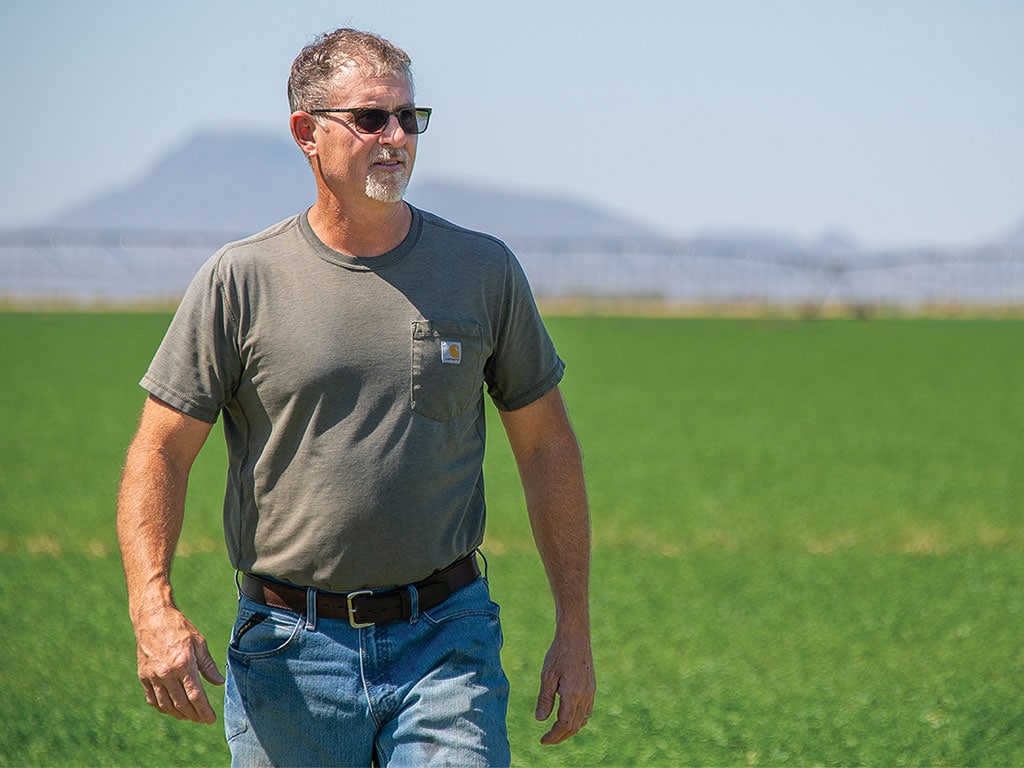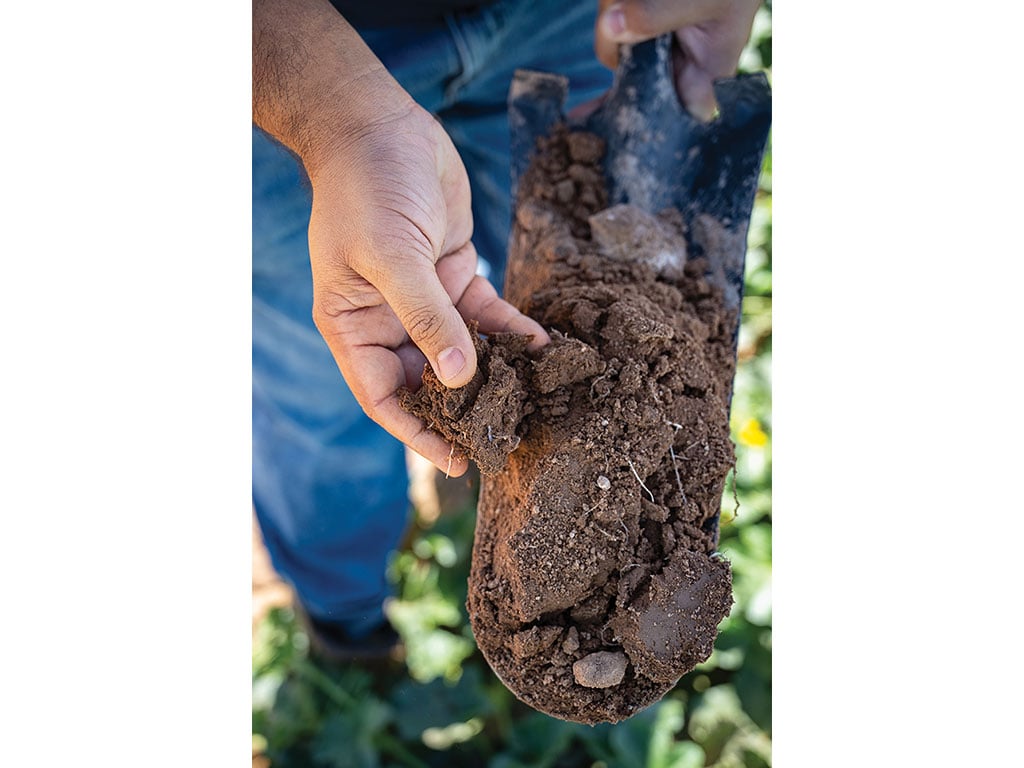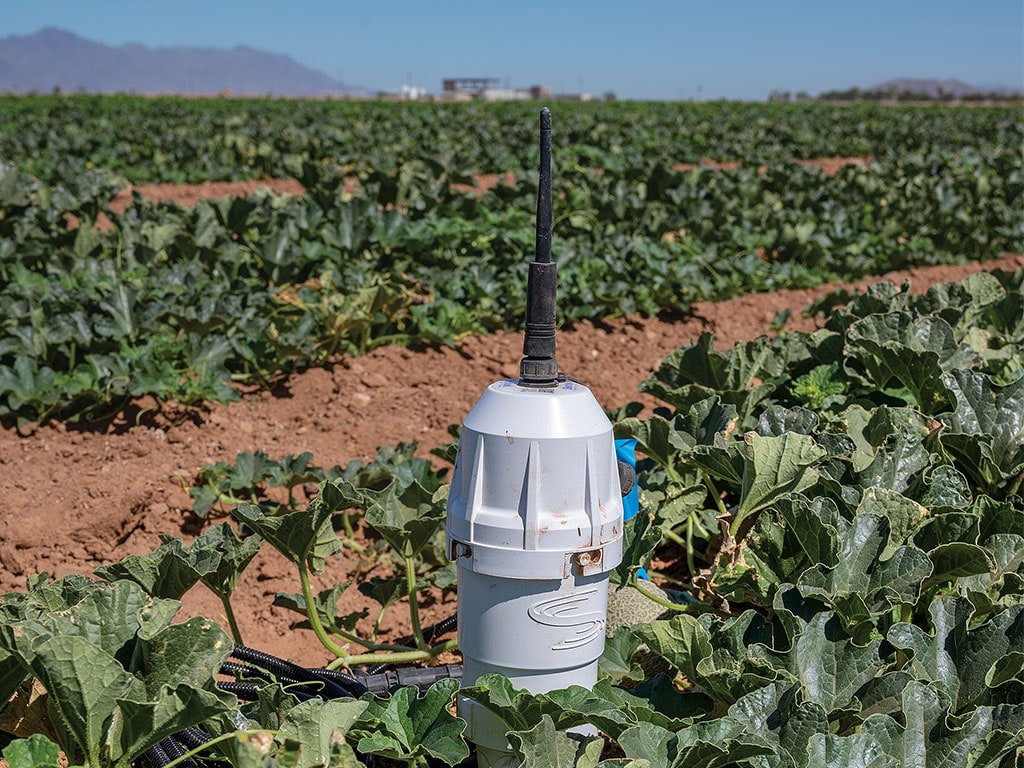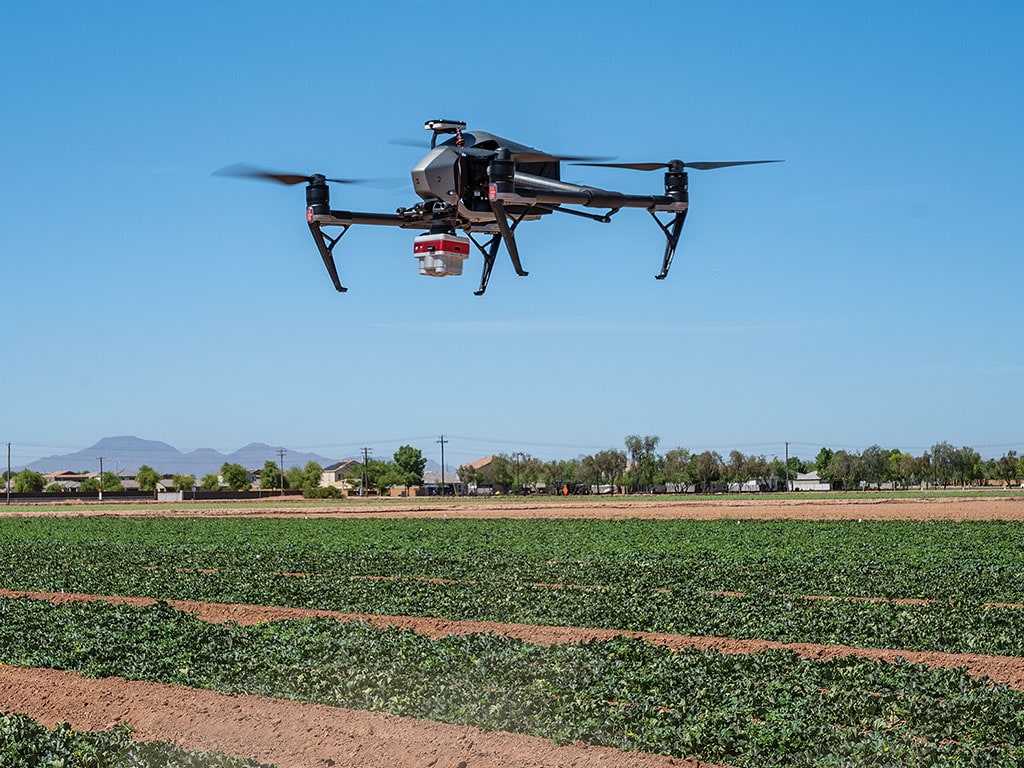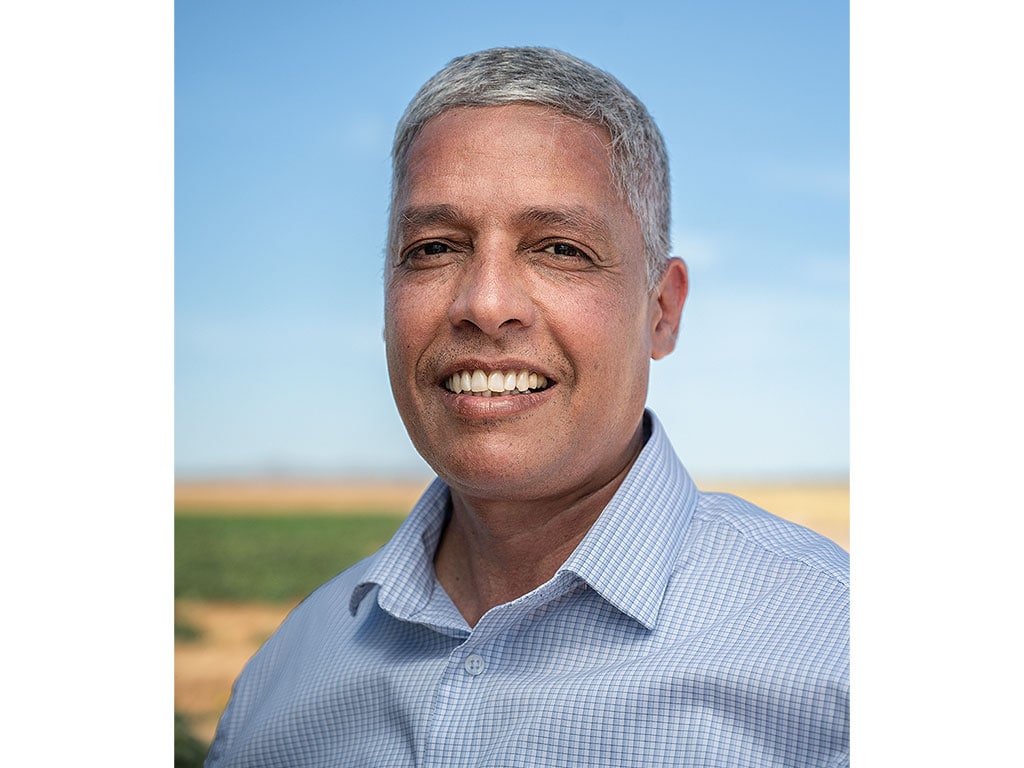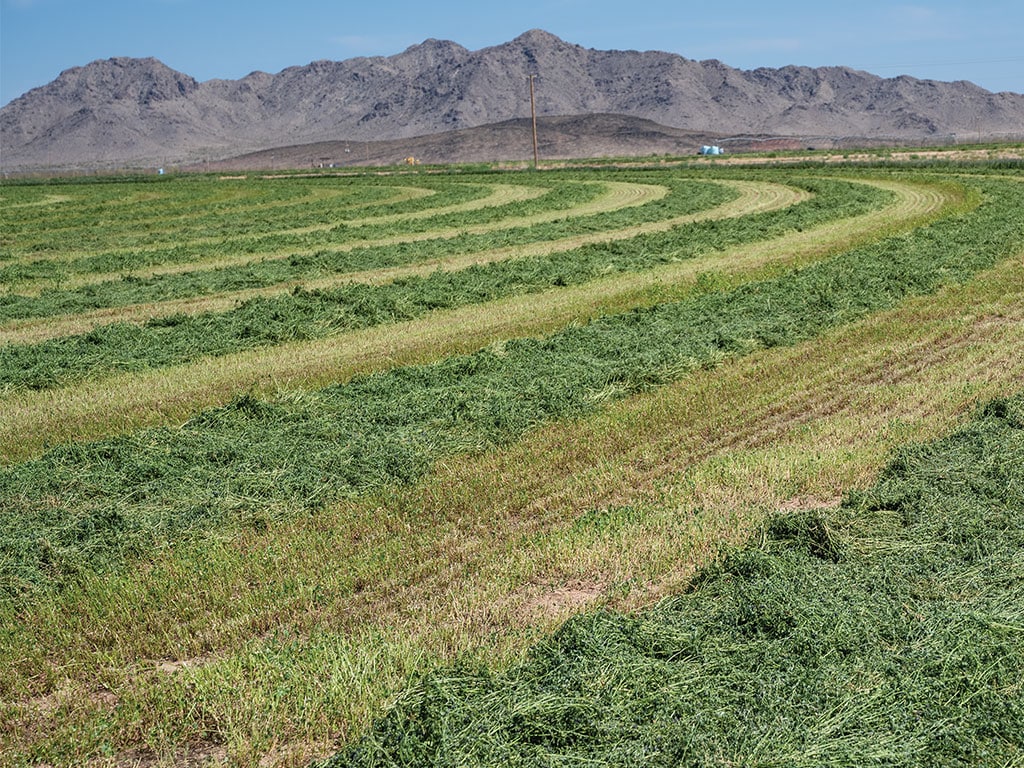
Arizona gets 350 days of sun allowing 10-12 alfalfa cuttings per year. "You need soil, sun, seed, and water to grow crops. Arizona has all the other resources needed in abundance, you just need water," says Ethan Orr. Though population has tripled and ag production doubled, the state used less water in 2022 than in 1962, he says.
Agriculture, Sustainability February 01, 2025
Slowing The Flow: Desert Water Makeover
Crisis funds pouring into Arizona irrigation upgrades drive wide-reaching change.
by Martha Mintz
Whiskey is for drinking. Water is for fighting. The opposite of this favorite saying is proving true as the people of Arizona work to innovate their way through an ongoing water crisis.
The Water Irrigation Efficiency Program (WIEP) pumped a total of $45 million into irrigation research and grants to help parched Arizona farmers install more water-efficient irrigation systems and technologies. The program has farmers, residents, and legislators in rare agreement and the results are flowing in.
Funds released in February 2023 were quickly utilized. As of October 2024, irrigation system upgrades on 110 farms in 11 of 15 Arizona counties converted 24,000 acres from flood to more efficient irrigation systems. The projects delivered 48,581 acre-feet of water savings per year.
That's enough to supply 145,000 Arizona households for a year and keep about 30,000 acre-feet of water in struggling Lake Powell, says Ethan Orr, associate director, Agriculture Natural Resources and Economic Development Arizona Cooperative Extension and director of WIEP.
"The cost per acre-foot saved was so low, and the amount of water we saved so significant, it has allowed me to engage in conversations about water with the public in a less divisive way," he says.
Even a normally contentious Arizona Legislature voted unanimously to allocate an additional $15 million to WIEP in 2023 on top of the initial $30 million allocated in 2022.
Similar funds applied to residential programs yielded savings of less than 20 acre-feet of water per year, the equivalent of a rounding error in the agricultural world, Orr says.
"Investing in agricultural systems is the most cost-effective way to significantly conserve water right now," he says.
Producer investment factors into that determination. Grants funded up to $1,500 per acre to install systems that can cost upward of $2,500 per acre. Producer contributions added $19 million in benefit to the $45 million program.
Farm impacts. Money isn't what drove producers in Pinal County to tap WIEP funds. When the 20-year mega-drought triggered Tier 2 water restrictions on the Colorado River, water availability for irrigation dried up in some areas. The Hohokam water district was allotted just 9 acre-inches, barely enough for a cover crop to hold the soil.
Growers had to switch to groundwater and pressurized systems or go out of business.
Before the water crisis, the general policy was to protect groundwater by using surface water. Fear of Lake Powell going dead pool (dropping so low water no longer flows downstream) drove an abrupt flip. Now Arizonans are tapping groundwater to save surface water.
"People rarely make good decisions in crisis," Orr says. Which is why WIEP funds allocated to research are a critical piece of the puzzle. "We need to stop, find our bearings, and navigate our way out of the forest. We don't want to solve a crisis this year that will create a generational crisis in the future."
Orr is working with farmers, agronomists, and irrigation, soil, and plant scientists to ensure shifting Arizona irrigation strategies keep agriculture on the right heading.
At the University of Arizona Maricopa Agricultural Center, researchers are evaluating systems and technologies, irrigation rates and frequency, inputs, and potential new water-efficient crops.
Side-by-side trials compare pressurized drip, gravity drip, and center pivot irrigation to flood in three crops. Crop yield and quality are being evaluated at 100% and 80% irrigation rates to see where more water savings might be gained.
They're also evaluating how each strategy impacts soil health and function. The team uses sensors to track soil moisture, temperature, and salinity at various depths and drones to collect data on parameters such as field temperature, canopy cover, and evapotranspiration.
"You have to look at the system as a whole," says Diaa Elshikha, Arizona State Irrigation Specialist. Less water can be used in pressurized systems than in flood irrigation for example, but flood irrigation flushes salts from the root zone.
"If we can't use a lot of water, we need alternative strategies, technologies, or amendments to manage salinity," says Debankur Sanyal, Arizona State Soil Specialist.
Above. Farmer Mike Paskett uses around half as much water with his pressurized irrigation system as compared to flood. Scientists are carefully monitoring how changing systems might impact soil health and function. Diaa Elshikha and other researchers are testing irrigation systems and technologies, evaluating crop water needs, and providing education and guidance as Arizona agriculture overhauls its water use to provide savings for all.
Spurring change. WIEP grant farms work with researchers for three years sharing data and testing technology. Ten farms received three years free use of soil moisture sensors to be used with irrigation management software. This program serves as part technology test, part reintroduction of technology farmers dismissed in the past.
"People tried cheap, $40 sensors. These are $1,800 sensors that monitor moisture and send data direct to their phones. They can access the information on a daily basis to guide irrigation," Elshikha says.
These technologies help researchers and producers balance water savings with yield.
"This year we grew melons with 20% less water than normal using irrigation models managed with phone applications," Elshikha says.
Gila Bend, Arizona, farmer Mike Paskett sees pressurized irrigation and technology as the obvious choice. He uses 18 pivots to irrigate 2,200 acres of alfalfa, potatoes, squash, corn and Teff grass.
"A ditch is archaic. Water is exposed to the atmosphere when evapotranspiration rates can reach 1/2-inch per day," he says.
He abandoned the crumbling, sand-filled ditches on the farm he and partner, SHB, purchased in 2015, installing pivots to bring the idle land back into production. WIEP grants funded more pivots, pipeline, and electricity.
"I'm using about half the water I would use to flood irrigate," Paskett says. Water is protected from evaporation until application and he has more control and flexibility in his system.
Paskett can use a little water to germinate crops or manage ground conditions for field work. His wells and pivots are all interconnected. If a well goes down, he can still pump water to any field.
"I monitor it all through a phone app. If a machine shuts off, I get a text and can address it immediately," he says.
Initial successes need to be maintained and built upon with scrutiny to avoid missteps.
"The first $30 million will help determine best use for the next $1 billion invested in water use efficiency programs," Orr says. ‡
Read More

AGRICULTURE, EDUCATION
The Erie Canal at 200
America's first massive infrastructure project set the stage for agriculture's success.

